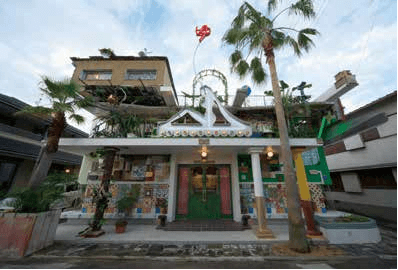Issue:
JAPAN’S INLAND SEA PLAYS HOST TO A UNIQUE ART EVENT THAT TAKES ISLAND TOURISM TO A NEW LEVEL
Art hopping through the islands
by Julian Ryall

photo by OSAMU WATANABE
Twenty five years ago, when Benesse chairman Soichiro Fukutake sailed his yacht through the islands of the Seto Inland Sea, the area was little more than a series of deforested islands devastated by unchecked industrialization and the illegal dumping of waste.
The damage to the environment was reflected in the residents of the islands, who were abandoning their traditional homes in search of work and a better life. Those who were obliged to stay behind lived among dilapidated houses and the other unmistakable signs of a community in terminal decline.
This summer and autumn, thanks to Fukutake’s efforts, those same islands are hosting the second Setouchi Triennale, an art event that is building an international reputation. This year’s event is featuring 210 artists from 23 countries.
A businessman and confirmed urban dweller, Fukutake told a press conference at the FCCJ on May 30 that his journey through the islands changed his perspectives on daily life and Japanese society. “I realized that although people live in cities, they are not always happy there,” he said. “Happiness cannot be achieved in that sort of competitive society.
“So what is a community of happy people?” he asked. “I believe it is one where a lot of elderly people live together. They may have many imperfections, they may no longer be physically fit and their mental capabilities may be fading, but they have achieved a long life and can have a happy community.”
Seeing the “terrible legacy of industrialization” that had been wrought on the islands despite the region’s designation as a national park Fukutake says he was “filled with a tremendous sense of anger.”
Channeling that fury into “resistance” against modern society, he set about convincing world class artists, designers and architects of his vision for a rejuvenated and thriving community across the islands, based on art.
It was not, however, an easy sell.“
It was back in 1988 when, out of the blue, Mr. Fukutake told me that he wanted to create something new, something that would be unique in the world of art,” renowned architect Tadao Ando told the press conference. “He told me that the Seto Inland Sea was an area of unprecedented beauty and that he wanted to create utopia.
“My immediate thought was that it was just an impossible dream; one that would never become reality,” he admitted. “I told him straight off that it would be impossible to attract world class artists to the region. But he told me he wouldn't give up, so I joined hands with him.”
The transformation over the intervening years has been little short of incredible.
Naoshima has built a reputation as one of the world’s best locations to see contemporary art. It is home to the Lee Ufan Museum, designed by Ando, the Benesse House Museum and the semi subterranean Chichu Art Museum, with its remarkable collection of no fewer than five of Claude Monet’s “Water Liles” series.
Nearby Teshima hosts Junya Ishigami’s Mountain Project, the Teshima Yokoo House and numerous other works and installations throughout the triennale. Similar events will be taking place on Megijima, Ogijima, Shodoshima, Oshima, Inujima, Shamijima, Honjima, Takamijima, Awashima and Ibukijima, as well as in the Shikoku port towns of Takamatsu and Uno.
The presence of art has a larger affect on these communities, Ando emphasized. Fukutake’s vision has been stretched to incorporate cultural programs that extend support for the Ibukishima dried sardine plant and the Naoshima rice growing project. A public bath on the same island is probably the only place in the world where a visitor can scrub off the day’s grime surrounded by an array of modern art.
There is more. A food project opened in conjunction with the first Setouchi Triennale in 2010 and is still going strong. A museum on Inujima features the history of the island’s granite quarrying and copper smelting industries, as well as the people who made the island home in generations gone by. The Art House Project on Naoshima is supporting an elderly couple who have decided to eschew retirement to operate an udon restaurant.
Fukutake says that what has been achieved in the Inland Sea could serve as a blueprint for Japan’s wider society.
“I believe that 10 percent of a company’s shares should be held by a foundation set up to help local communities and enhance culture,” he said. “I want to promote a new kind of capitalism, first in Japan and then spread throughout the world.
“I believe that the economy should serve culture, not the other way around,” he said. “Culture should be the ultimate goal, not the economy.”
The Setouchi Triennale 2013 holds events from July 20 to Sept. 1, and Oct. 5 to Nov. 4, over 12 islands of the Seto Inland Sea. More information, including tickets and access, can be found at: http://setouchi-artfest.jp/

